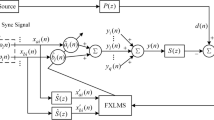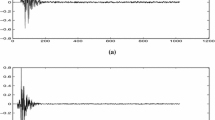Abstract
Frequency domain filtered-x least mean square algorithms can reduce the computational complexity of the time domain counterpart with long filters; however, they suffer from large block delay, additional quantization error due to large size transformations and implementation difficulties in existing DSP hardware. In this paper, a time–frequency domain flexible structure is proposed using the partitioned block frequency domain adaptive filtering technique, which has no signal path delay and is well suited for low-cost DSP implementation. The proposed structure divides the long filters into many equal partitions and carries out the control filter update in frequency domain while generating the control signal in both time and frequency domains, thereby eliminating the forward path delay completely while maintaining low computational complexity. The proposed structure has a potential benefit for controlling broadband noise, where the causality constraint is more important. The simulation results using the measured acoustic paths demonstrate that the proposed structure maintains similar control performance as that of the time domain algorithm but with much less computational complexity. Furthermore, the tracking performance of the proposed structure under different levels of measurement noise is investigated.






Similar content being viewed by others
Data Availability
Data sharing was not applicable to this article as no datasets were generated or analysed during the current study, and detailed simulation results are given in the manuscript.
References
Y. Bendel, D. Burshtein, O. Shalvi, E. Weinstein, Delayless frequency domain acoustic echo cancellation. IEEE Trans. Speech Audio Process. 9(5), 589–597 (2001)
J.P. Borrallo, M.G. Otero, On the implementation of a partitioned block frequency domain adaptive filter (PBFDAF) for long acoustic echo cancellation. Signal Process. 27(3), 301–315 (1992)
K.S. Chan, B. Farhang-Boroujeny, Analysis of the partitioned frequency-domain block LMS (PFBLMS) algorithm. IEEE Trans. Signal Process 49(9), 1860–1874 (2001)
D.C. Chang, F.T. Chu, Feedforward active noise control with a new variable tap-length and step-size filtered-X LMS algorithm. IEEE/ACM Trans. Audio Speech Lang. Process. 22(2), 542–555 (2014)
D.P. Das, D.J. Moreau, B.S. Cazzolato, A computationally efficient frequency-domain filtered-X LMS algorithm for virtual microphone. Mech. Syst. Signal Process. 37, 440–454 (2013)
D.P. Das, G. Panda, S.M. Kuo, New block filtered-X LMS algorithms for active noise control systems. IET Signal Process. 1(2), 73–81 (2007)
K.K. Das, J.K. Satapathy, Frequency-domain block filtered-x NLMS algorithm for multichannel ANC, in IEEE International Conference on Emerging Trends in Engineering and Technology (2008), pp. 1293–1297.
S. Elliott, Signal Processing for Active Control (Elsevier, 2000)
S.J. Elliott, C. Boucher, Interaction between multiple feedforward active control systems. IEEE Trans. Speech Audio Process. 2(4), 521–530 (1994)
B. Farhang-Boroujeny, K.S. Chan, Analysis of the frequency-domain block LMS algorithm. IEEE Trans. Signal Process. 48(8), 2332–2342 (2000)
E. Ferrara, Fast implementations of LMS adaptive filters. IEEE Trans. Acoust. Speech Signal Process. 28(4), 474–475 (1980)
M. Ferrer, M. Diego, G. Piñero, A. Gonzalez, Active noise control over adaptive distributed networks. Signal Process. 107, 82–95 (2015)
A. Kar, M. Chandra, Performance evaluation of a new variable tap-length learning algorithm for automatic structure adaptation in linear adaptive filters. AEU Int. J. Electron. Commun. 69(1), 253–261 (2015)
X. Kong, S.M. Kuo, Study of causality constraint on feedforward active noise control systems. IEEE Trans. Circuits Syst. II Analog Digit. Signal Process. 46(2), 183–186 (1999)
S.M. Kuo, D. Morgan, Active Noise Control Systems: Algorithms and DSP Implementations (Wiley, 1995)
C. Liu, Z. He, W. Xia, A frequency domain LMS algorithm with dynamic selection of frequency bins. Circuits Syst. Signal Process. 31(6), 2103–2118 (2012)
J. Lu, X. Qiu, H. Zou, A modified frequency-domain block LMS algorithm with guaranteed optimal steady-state performance. Signal Process. 104, 27–32 (2014)
E. Moulines, O.A. Amrane, Y. Grenier, The generalized multidelay adaptive filter: structure and convergence analysis. IEEE Trans. Signal process. 43(1), 14–28 (1995)
T. Murao, C. Shi, W.S. Gan, M. Nishimura, Mixed-error approach for multi-channel active noise control of open windows. Appl. Acoust. 127, 305–315 (2017)
T. Padhi, M. Chandra, A. Kar, M.N.S. Swamy, A new hybrid active noise control system with convex combination of time and frequency domain filtered-x LMS algorithms. Circuits Syst. Signal Process. 37(8), 3275–3294 (2018)
S.J. Park, J.H. Yun, Y.C. Park, D.H. Youn, A delayless subband active noise control system for wideband noise control. IEEE Trans. Speech Audio Process. 9(8), 892–899 (2001)
S. Pradhan, X. Qiu, A 5-stage active control method with online secondary path modelling using decorrelated control signal. Appl. Acoust. 164, 107252 (2020)
S. Pradhan, G. Zhang, X. Qiu, A time domain decentralized algorithm for two channel active noise control. J. Acoust. Soc. Am. 147(6), 3808–3813 (2020)
X. Qiu, N. Li, G. Chen, C.H. Hansen, The implementation of delayless subband active noise control algorithms, in International Symposium on Active control of Sound and Vibration (2006), pp. 17–26.
N.K. Rout, D.P. Das, G. Panda, Computationally efficient algorithm for high sampling-frequency operation of active noise control. Mech. Syst. Signal Process. 56, 302–319 (2015)
Q. Shen, A. Spanias, Time and frequency domain X block LMS algorithms for single channel active noise control, in International Congress on Recent Developments in Air-and Structure-Borne Sound Vibration (1992), pp. 353–360.
Q. Shen, A. Spanias, Time-and frequency-domain X-block least-mean-square algorithms for active noise control. Noise Control Eng. J. 44(6), 281–293 (1996)
J.J. Shynk, Frequency-domain and multirate adaptive filtering. IEEE Signal Process. Mag. 9(1), 14–37 (1992)
J.-S. Soo, K.K. Pang, Multidelay block frequency domain adaptive filter. IEEE Trans. Acoust. Speech Signal Process. 38(2), 373–376 (1990)
J. Thi, D.R. Morgan, Delayless subband active noise control, in IEEE International Conference on Acoustics, Speech, and Signal Processing (1993), pp. 181–184.
J. Wang, J. Xue, J. Lu, X. Qiu, A switching strategy of the frequency-domain adaptive algorithm for active noise control. J. Acoust. Soc. Am. 146(2), 1045–1050 (2019)
F. Yang, G. Enzner, J. Yang, Transient analysis of partitioned-block frequency-domain adaptive filters, in European Signal Processing Conference (2019), pp. 1–5.
F. Yang, M. Wu, J. Yang, A computationally efficient delayless frequency-domain adaptive filter algorithm. IEEE Trans. Circuits Syst. II Express Briefs 60(4), 222–226 (2013)
Y. Zhou, J. Chen, X. Li, A time/frequency-domain unified delayless partitioned block frequency-domain adaptive filter. IEEE Signal Process. Lett. 14(12), 976–979 (2007)
Acknowledgements
This research was supported under the Australian Research Council’s Linkage Project funding scheme (No. LP160100616).
Author information
Authors and Affiliations
Corresponding author
Ethics declarations
Conflict of interest
The authors declare that they have no conflict of interest.
Additional information
Publisher's Note
Springer Nature remains neutral with regard to jurisdictional claims in published maps and institutional affiliations.
Rights and permissions
Springer Nature or its licensor (e.g. a society or other partner) holds exclusive rights to this article under a publishing agreement with the author(s) or other rightsholder(s); author self-archiving of the accepted manuscript version of this article is solely governed by the terms of such publishing agreement and applicable law.
About this article
Cite this article
Pradhan, S., Qiu, X. & Ji, J. On Time–Frequency Domain Flexible Structure of Delayless Partitioned Block Adaptive Filtering Approach for Active Noise Control. Circuits Syst Signal Process 42, 7580–7595 (2023). https://doi.org/10.1007/s00034-023-02463-7
Received:
Revised:
Accepted:
Published:
Issue Date:
DOI: https://doi.org/10.1007/s00034-023-02463-7




